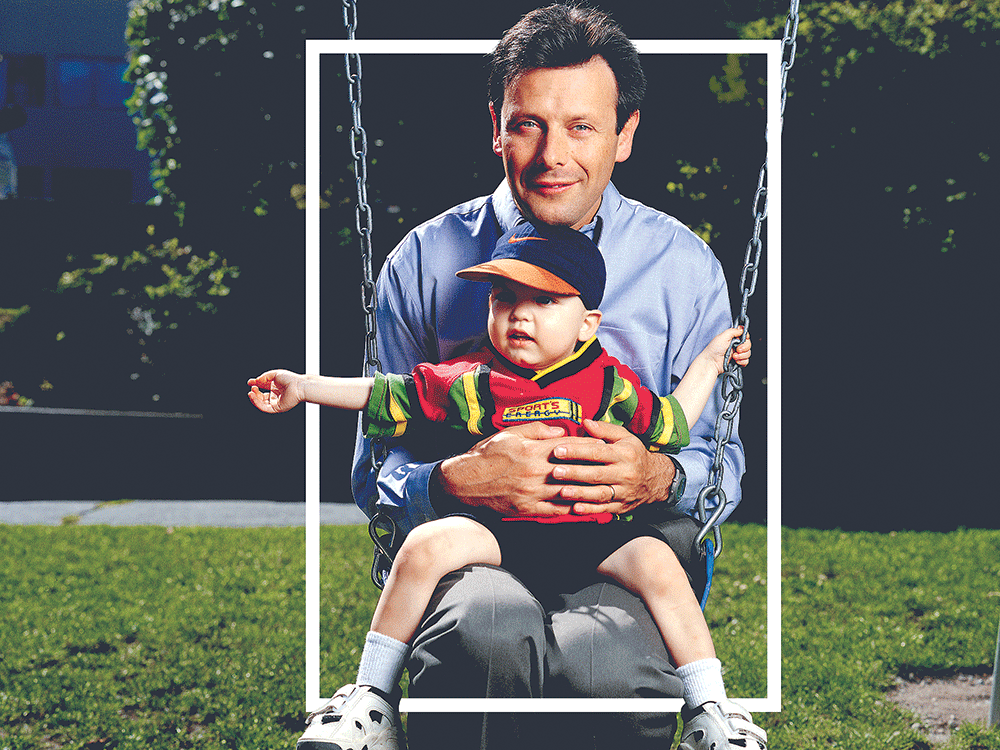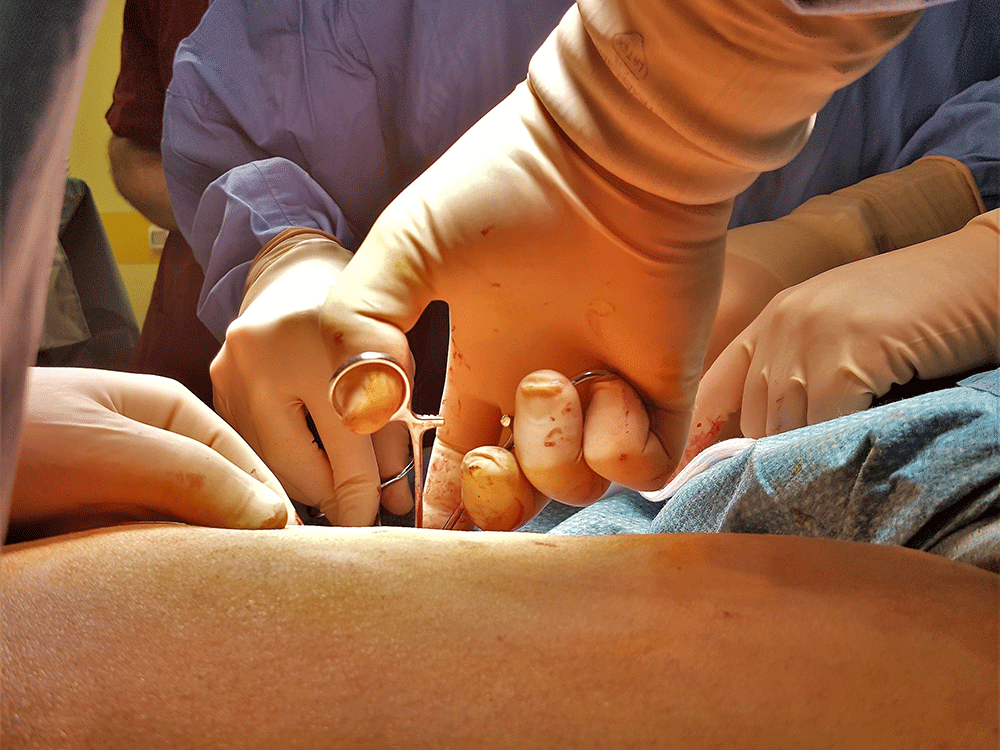
Catastrophe Strikes on Christmas
“Mommy! Daddy! Santa was here!”
Jerry and Beth Granger of Port Moody, B.C., smiled as their three children—Tamara, seven, Kimberly, three, and Bradley, almost two—beelined for the presents piled under the tree early on Christmas morning, 1998.
“Wait until I do Bradley’s finger poke,” Beth told the girls. She sat down on the couch and lifted the toddler onto her lap. He obediently held out his finger while Beth, 27, pricked it with a needle and squeezed out a drop of blood—something she had done four times a day for most of her son’s life. Bradley suffered from type 1 diabetes, a chronic disease requiring regular monitoring and two or more daily insulin injections to regulate his blood sugar.
A sunny child, Bradley never balked at getting needles. He loved clowning around to make his family laugh, but this morning, while the girls wriggled with impatience to get at their stockings, he sat listlessly on the couch as Beth put his blood sample into a hand-held glucose monitor.
She was shocked by the number that appeared on the screen. Bradley’s blood sugar was lower than she had ever seen it. “Get me some pop, quick!” she told Jerry. The little boy drank the soda to boost his blood sugar, but he was still drowsy. Beth administered his insulin injection and he fell asleep on the couch. His parents assumed he was suffering the after-effects of the virus that had given the whole family coughs and sniffles a few days earlier.
After lunch, Beth did another blood test. This time, Bradley’s blood sugar was so high that it didn’t register on the monitor. In disbelief, Beth checked it again, with the same result. “What’s going on?” she asked Jerry in alarm.
She called British Columbia’s Children’s Hospital, in nearby Vancouver, and had Bradley’s doctor, pediatric endocrinologist Daniel Metzger, paged. He reassured Beth, telling her that fluctuating blood sugar is normal in diabetic children, especially during the holidays, when they’re tempted by sweets. Following his instructions, Beth gave Bradley another injection, and the boy fell asleep again.
Beth began preparing dinner. At 4 p.m., she woke him for another test. Again, his blood sugar was too high to register, and again she called Metzger. Give Bradley more insulin, he advised.
Soon Beth’s parents arrived for Christmas supper. As the family ate, Beth’s gaze kept wandering to the small form sleeping on the couch. Then her eyes met her husband’s. Jerry, also 27, was a devoted father. Each knew the other was worried.
Bradley had never suffered any complications from diabetes, and his elevated blood sugar was far too unusual to ignore.
Beth got up from the table and poked her son’s finger again. His blood sugar was still too high, and now his arms and legs were limp and his skin had begun to turn grey. Frightened, Beth phoned Metzger. “Bring him in,” he said. “I’ll meet you.”
She wrapped Bradley in a blanket. “Be good, girls,” she told her daughters, trying to keep her voice calm. “We’ll be home soon.”
As Beth sat beside Bradley, now in his car seat, the boy’s eyes closed and his head lolled forward onto his chest. “Bradley, wake up!” she yelled. She feared her son was slipping into a diabetic coma, a potentially fatal condition. “Don’t go to sleep, baby!” she begged.
Jerry made the 40-minute trip to the hospital in half that time. Metzger was waiting when the van pulled up in front of the emergency department. Medical staff snatched Bradley out of his mother’s arms and began to measure his vital signs. Blood samples were taken and sent to the lab.
A short while later, Metzger returned. “Bradley’s condition has nothing to do with his diabetes,” he said.
“Then what is wrong with him?” Jerry demanded.
“We don’t know yet,” Metzger admitted. “We have to do some tests.”
Beth and Jerry followed as Bradley was wheeled on a gurney to the intensive care unit. The boy gave them one last look before falling into a deep sleep.
Beth thought about how tiny her son looked in the big hospital bed. Two IV lines, one for drugs and one for insulin, ran into the back of his hands. A third line entered his right wrist so blood could be taken more easily. His hands were taped to plastic splints so he wouldn’t be able to move them, and a catheter was inserted so urine could be collected for testing.
Beth sat beside the bed, stroking Bradley’s forehead. Jerry sat on the other side, his big hand resting on his son’s leg.
Late that night, Bradley began to breathe unevenly, his gasps loud in the hushed room. He was put on a respirator.
Boxing Day dawned: Jerry and Beth’s wedding anniversary. They spent the day hunched anxiously over Bradley’s bed.
Late in the afternoon, Rick Schreiber, a pediatric gastroenterologist who specializes in liver disease, entered the room and told them the news: Bradley’s liver had shut down, and he wasn’t responding to drugs. Without a liver, he would die. His only hope was a transplant.

A Risk Worth Taking
Beth burst into tears, and Jerry put his head against the wall, his shoulders shaking with sobs.
All pediatric liver transplants in Western Canada are performed in Edmonton, at the transplant centre at the University of Alberta Hospital. Since there wasn’t room for both parents to accompany Bradley on the medical jet, the hospital arranged a commercial flight for Jerry.
Before leaving for Vancouver airport, Jerry bent over his unconscious son.
“Keep fighting, buddy,” he said. Shortly after, Beth and Bradley lifted off and flew into the night.
James Shapiro, 36, a liver transplant surgeon, was on call when the phone rang at his home with the news about Bradley. The little boy en route to Edmonton had been designated 4F: the 4 meaning top priority, the F meaning fulminant, or dying. By the time Shapiro reached the hospital, staff members of the Human Organ Procurement and Exchange (HOPE) program in Alberta had called other donor programs across Canada, checking for possible livers. There were none.
For Shapiro, there were echoes of a previous experience. Born and trained in England, he came to Canada in 1993 to complete a two-year transplant fellowship. One of his cases was an eight-year-old boy named Christopher who was suffering from acute liver failure. Doctors kept Christopher alive for three days while waiting for a donor. Then the good news arrived: an organ had been found.
But it had come too late. Shapiro was in the middle of surgery when tests showed that the child’s liver failure had caused excess fluid to build up in his skull. Christopher was brain dead, and the operation was never completed.
The young surgeon was devastated. A father himself, Shapiro wanted to save other parents from this experience. He remembered reading an article about living transplants, a procedure in which part of a living adult’s liver is transplanted into a child. Both livers then rejuvenate into fully functioning organs.
The University of Alberta had offered Shapiro an assistant professorship in surgery. He accepted on one condition: that he be allowed to study living-transplant surgery in Japan, where the procedure was pioneered. Earlier that year, Shapiro had spent three months with the world’s top living-transplant expert, Koichi Tanaka, in Kyoto. The Canadian surgeon had assisted in 30 living-transplant operations during his time in Japan.
Now, three months after returning to Edmonton, Shapiro was looking at Bradley’s test results. He realized that the toddler was just hours from death, and he wondered if a living transplant could save Bradley. Only five such operations had been done in Canada, and none on a dying child.
After Beth arrived in Edmonton with Bradley, Shapiro met with her in the transplant centre’s waiting room. He explained that it might be possible to take a piece of liver from her or Jerry. “Don’t give me an answer now,” he said. “When your husband arrives, I’ll talk to both of you.”
Jerry pulled up in a cab soon after. He had spent the flight to Edmonton trying to face the fact that his son could soon die. When Beth explained what Shapiro had told her, he didn’t need to think it over. “Let’s do it,” he said.
The liver is the largest organ in the body, located on the right side of the abdomen, behind the lower ribs. It’s a complex organ: divided into two lobes, it cleanses the blood and manufactures the bile that eliminates toxic substances. As the liver begins to die, toxins flood the blood system and are carried to every part of the body. The brain begins to accumulate surplus fluid that hasn’t been cleaned by the liver, the kidneys become poisoned, and the patient has difficulty breathing.

A Second Chance at Life
The respirator had replaced Bradley’s lungs, and the dialysis machine had replaced his kidneys, but no machine can replace the liver. Massive injections of adrenalin-type drugs coursed through the boy’s body to keep his blood pressure stable.
Tests showed that both parents were compatible donors. The question now was: which of them would donate? Jerry was determined to do it. He convinced Beth by reminding her that she was the family “doctor,” the one who gave Bradley his insulin injections and treated the girls if they were sick or hurt. “If Bradley pulls through,” Jerry reasoned, “he’s going to need a lot of care. You’re the best one to look after him.”
The double operation began at 7 a.m. on December 27—Bradley’s second birthday. Norman Kneteman, head of the liver transplant team, performed the first operation, assisted by Shapiro. Kneteman began with a long incision from one side of Jerry’s torso to the other, then a second from the chest downward.
The ribs were pulled apart to expose the liver. Then Kneteman carefully cut a 15-by-15-centimetre triangular piece—about one quarter of Jerry’s liver—from the left lobe.
Connected to this piece were three main vessels: the major vein that carries blood into the left lobe of the liver, called the left portal vein; the left hepatic artery; and the left hepatic vein, which drains the left lobe. Kneteman cut all three but left the vena cava, the main portal vein and the main hepatic artery intact in order to supply blood to the remaining lobe of the liver. He then removed the piece of liver, with its three stumps attached, and placed it in a nutrient solution and then an ice slush, cooling it to 4 C.
Jerry’s surgery took six hours. Now the doctors were ready for Bradley.
When staff arrived to take Bradley to the operating room, Beth gave him one last kiss. “I love you,” she whispered. “Mommy will be waiting right here when you wake up.”
Shapiro began to work on the dying child. First he cut Bradley’s torso open and removed his liver. It was snow white, which meant it didn’t contain any living cells.
Shapiro carefully took the piece of Jerry’s healthy liver and positioned it in the boy’s abdominal cavity. It was a tight fit. Shapiro took the first of three steps: connecting the left hepatic vein leading from the liver to Bradley’s vena cava. Joined by Kneteman, who was now finished with Jerry, Shapiro then began the second step: attaching the stump of the liver’s portal vein to Bradley’s portal vein. Since Jerry’s veins were much bigger than Bradley’s, this was like coupling a large pipe with a smaller one.
Shapiro then carefully undid the clamps that sealed off the vessels. The surgical team watched with anticipation as blood surged from Bradley’s body through the newly stitched veins and into the liver, turning it from brown to pink and warming it to body temperature.
Midnight had passed when the two surgeons began the third and most difficult step: sewing the tiniest artery on the transplanted liver to Bradley’s own hepatic artery, which was even smaller. For this, Shapiro bent over a powerful microscope that magnified the arteries, making infinitesimal stitches with fine filament.
The team members held their breath as Shapiro made the last stitch. Then he undid the last clamp. Suddenly, rich, golden bile began to pour from the bile duct—proof positive that the new liver was working.
Twenty hours had passed since the first surgery began.
Beth was slumped beside her sleeping husband when her pager went off. She raced up to the fourth floor. “The surgery went perfectly,” said Shapiro when he walked into the waiting room. Beth threw her arms around his neck. “Thank you for saving my baby!” she said.
She spent the next few days at her son’s bedside. It wasn’t until New Year’s Day that Bradley’s eyes opened and looked into hers. He couldn’t move or speak, but Beth knew he recognized her.
“Hi, buddy,” she said softly. “Welcome back.”
Bradley recuperated from his surgery and returned home on March 12, 1999. Jerry had left the hospital five days after his operation and is now recovered.
Unfortunately, Bradley died shortly before his 14th birthday, due to kidney failure. “It was very sad. He did well through his young years,” says Shapiro. “But most kids who get transplants go on to live full lives.”